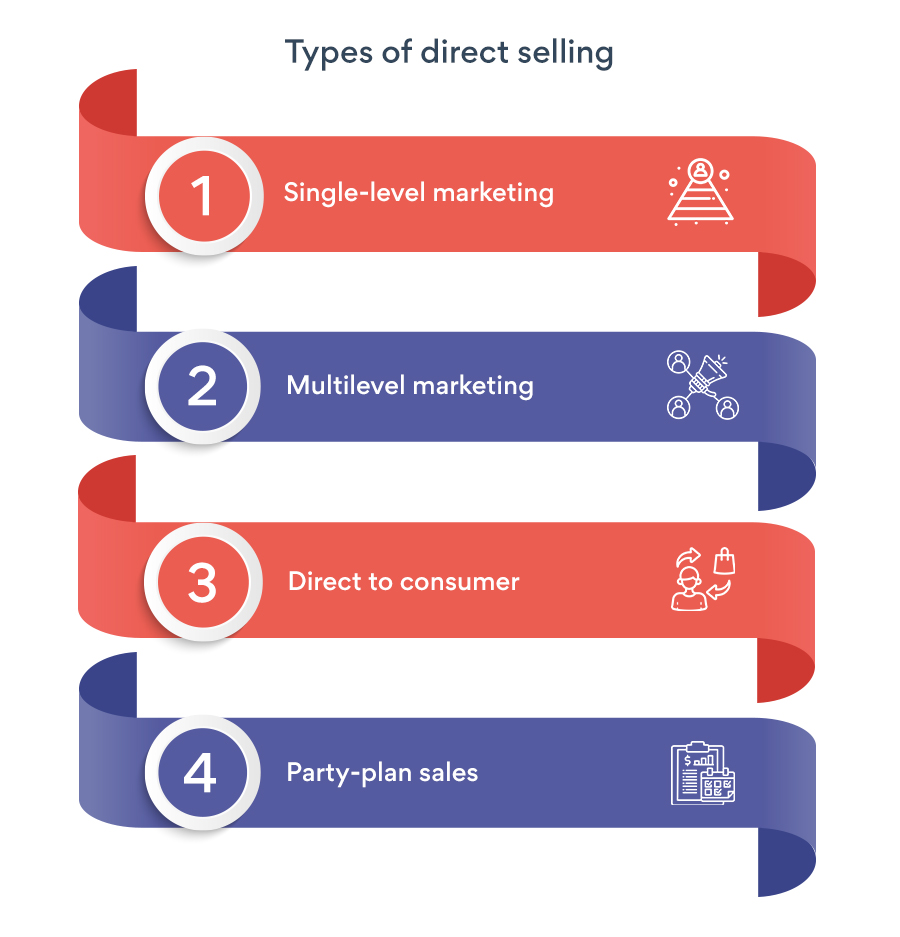When we think about 'Business', it brings forth the image of a salesperson handing out a product to a customer in exchange for money. However, business is indeed more than that. It is the journey from product conception to team building, to identifying the target market, promoting your brand, and then to the final stage of selling the product. Making a sale requires a lot of strategizing and planning. This is where sales and marketing come in.
Sales and marketing are critical for any business to thrive in the market. Companies work towards building solid, dynamic teams in both departments to ensure their product and brand image reach their target customers and generate leads consistently.
That said, businesses must develop strategies that align with their objectives and sales targets.
Direct selling and direct marketing are two popular choices for improving sales and customer relations. The method of engaging customers one-on-one to sell the products and services is known as direct selling. On the other hand, direct marketing involves communicating face-to-face, instead of via mass media, with the customers to promote the business's offerings.
Direct sales vs direct marketing is an ongoing debate. Both strategies have pros and cons, differences, and ways to help build your business. Read on to learn more about direct sales vs direct marketing.
Understanding direct selling
Businesses often prefer to approach their customers directly through their hired sales executives without setting up showrooms or wholesale outlets. Direct selling is a more enterprising technique to generate business vis-a-vis conventional selling strategies. The latter relies on standard retail channels such as brick-and-mortar shops or traditional advertising to interact with its market.
Being a non-conventional business model, it has been proven to increase product sales by 25%—more than the traditional sales model, which only promises a 5% hike.
Direct selling is a retail strategy that global brands such as Nutralite and Avon implement to sell and market their products to a worldwide customer base. Besides ensuring sales, direct selling is also a great way to cultivate customer relations and build a low-cost startup.
It inspires entrepreneurs to start their companies without investing too much in setting up retail outlets and hiring a large sales team full-time. This strategy is often a popular choice for businesses with extra capital for overhead and startup costs and who want to cover a vast market rapidly.
Types of direct selling
Direct selling is an umbrella term consisting of four categories of sales—Single Level Marketing (SLM), Multi Level Marketing (MLM), Direct to Consumer (D2C), and Party-Plan Sales.

Single-level marketing: Like all direct sales categories, this strategy requires the distributor to engage one-on-one with the customers via telephone or face-to-face. Single-level marketing involves a salesperson or distributor hired on a commission basis by a business to promote and sell their product. Distributors buy the products from the parent company, sell the products to the customers, and pocket the margin.
Multi-level marketing: Multi-level marketing follows the concept of single-level marketing, where the participants sell a company's products on a commission basis. The only difference between single-level and multi-level marketing is that MLM allows distributors to build their teams or 'downlines' and earn commission from their sales.
Direct-to-consumer: The D2C model allows businesses to sell directly to customers without intermediaries. D2C includes selling products and services through websites, referrals, or social media marketing. Numerous businesses create dynamic social media strategies involving running ads, creating content, and working with influencers to increase customer reach.
Party-plan sales: This is another unique direct selling approach that involves promoting and selling products and services to a group of people. It is called 'party-plan sales' because this direct sales method mainly occurs at social gatherings, parties, etc.
Advantages of direct selling
Direct selling has a lot of benefits for MLM businesses as well as for individuals considering it as a passive income or career option.
- 1. Flexibility for sellers: Direct selling enables the participants to work from anywhere. It does not require them to relocate; they don't have to go to the office. Direct selling allows candidates to work remotely and, in return, provides businesses with a geographically vast market. Besides, the industry welcomes candidates of all age groups, educational qualifications, and genders.
Also Read: Women in Direct Selling
- 2. Low startup costs: A primary advantage of implementing direct selling for your business is that it does not require you to invest large amounts of money into recruiting a full-time sales team or opening retail outlets to sell to customers. Companies using direct selling are free to sell their products and services online, via telephone, or face-to-face.
- 3. Direct customer feedback: Most business strategies don't have a precise feedback mechanism that is reliable and entirely trustworthy. Since direct selling revolves around interacting with customers directly, it allows businesses to get clearer and proper customer feedback–' straight from the horse's mouth'!
- 4. Personalized approach: Direct selling provides a personalized touch to the sales pitch since distributors contact customers upfront. Direct sales participants can offer customized solutions to their audience and individualize product demonstrations to fit their customers' pain areas.
- 5. Relationship building: The direct sales approach includes door-to-door and face-to-face selling techniques. They help establish a long-lasting, strong customer rapport. This not only improves the brand's image and sales but also builds loyalty for the brand.
- 6.Demonstrations and presentations: What makes direct selling a better alternative to selling products, compared to other business models, is its direct contact with the buyer. Direct selling involves organizing group presentations and product demonstrations so customers can better understand the brand and its products. This engages the customers more than other means of marketing and helps them overcome any bias or confusion regarding the brand or its products.
Challenges of direct selling
While the direct sales approach has helped businesses achieve positive results, it also has drawbacks. Following are some of the disadvantages of implementing direct selling as a sales strategy:
Limited reach: Direct selling often relies on one-on-one interactions or small group meetings, typically conducted by individual sales representatives. Unlike traditional retail or online sales that can reach a broad audience through physical stores or digital platforms, direct selling's immediate reach is inherently more limited.
Dependence on personal networks: Driving a direct selling venture towards success primarily means relying on the individual networks of its sales representatives. Bulk sales in this field often hinge on leveraging personal relationships to generate sales and recruit new team members, as in the case of MLM. This frequently leads to exhaustion of the networks, reluctance, and resistance of the connections to join the downline, and failure to grow the network enough to earn substantial margins.
Stigma or misconceptions about direct selling: Direct selling has been associated with various negative perceptions and misconceptions, partly due to its connection with multi-level marketing, similar to pyramid schemes. Due to this, many companies and individuals remain apprehensive about implementing this strategy to grow their businesses and think of it as a potential income source.
Direct selling companies can overcome these challenges with an AI-driven direct sales software that can track various business metrics tied to these challenges and deliver insights to increase operational efficiency.
Discover how we build resilient businesses with advanced MLM functionalities
| Direct Selling: Pros and Cons | |
|---|---|
| Pros | Cons |
| A flexible working environment offers remote working opportunities for everyone. | Campaigns are more localized and do not provide a vast audience. |
| Low investment required. | Sales are dependent on personal networks. |
| Better customer feedback, improved customer relations. | Often perceived to be illegal and fraudulent. |
| Global market reach due to a vast sales team. | |
| Customers have a better understanding of the brand. | |
Understanding direct marketing
According to the American Marketing Association (AMA), the term 'marketing' refers to "the activity, set of institutions, and processes for creating, communicating, delivering, and exchanging offerings that have value for customers, clients, partners, and society at large."
Simply put, marketing promotes a business to its target market online or offline.
Direct marketing revolves around one-on-one, direct communication with the customer. It eliminates any intermediaries (such as mass media and traditional advertising), and the business executes the marketing activities for the customer.
Unlike traditional marketing campaigns that rely on third-party channels like media publications or mass media, direct marketing campaigns communicate directly with target audiences. In direct marketing, companies use social media, email, mail, or phone/SMS campaigns to deliver their messages and sales pitches. Despite the large volume of communications, direct marketing often personalizes messages by including the recipient's name or city to increase engagement.
Other ways of direct marketing include sending company catalogs, newsletters, and promotional letters to the customers in their database to keep them up-to-date on all their products and services.
Types of direct marketing
Direct marketing is an innovative way for businesses to generate leads without investing immense cash in traditional marketing methods. Direct marketing comprises eight techniques:
Telemarketing: Cold calling potential or existing clients to promote and sell products or services.
Email marketing: Businesses contact consumers about their latest products, upcoming events, special offers, etc, via email. Consumers can subscribe to the company's email list, or companies can buy verified consumer email lists from mailing list services. Newsletters, promotional emails, and advertisements are some examples of email marketing.
Text marketing: Companies reach out to consumers through text messages. It can include:
- Messages: Short message service where recipients can respond to brief questions and provide the company with information about their preferences.
- Links: Messages containing a link to the company's website, allowing recipients to get more information or opt-in to receive mobile offers.
- Push notifications: Alerts are sent directly to the recipient's mobile device by the company. Example: Zomato, Swiggy, Uber.
Direct mail: Businesses send information about products, special offers, services, and sales directly to a customer's address via the postal service. Direct mail includes letters, flyers, brochures, and product catalogs.
Kiosk marketing: Kiosk marketing helps businesses reach out to a large percentage of their target market in a crowded setting, such as malls, fairs, etc, to promote their products and services.
Social media marketing: A pocket-friendly marketing approach for businesses on a tight budget. Social media marketing involves connecting with consumers, building brand awareness, driving business transactions, and promoting special offers on platforms like Instagram, Facebook, X, and LinkedIn. Companies can also invest in advertising programs to boost posts and extend their reach, attracting more users and increasing sales.
Direct response marketing: A part of direct marketing is the 'call to action', which prompts the recipient to express interest and respond. This can happen by calling a toll-free number, sending a reply card, or clicking a link in a social media or email promotion. This approach is commonly known as direct response marketing. This direct marketing approach includes TV commercials, newsletters, and promotional SMSes.
Internet marketing: The search engine enables businesses to reach a global market digitally since it uses online search engines to generate traffic to a company's website. It promises a diverse audience for advertisements and content, customer engagement, and retention. Some examples of internet marketing include display advertisements and pay-per-click ads.
Advantages of direct marketing
Moving forward with the direct selling vs direct marketing discussion, the following are the advantages of implementing direct marketing as your business strategy:
Broad reach: Direct marketing allows businesses to reach a vast audience directly. This expansive reach is facilitated by multiple platforms, ensuring that companies can campaign to diverse demographics, from local communities to international markets. As a result, it also helps companies to tap into new customer bases and expand their market presence significantly.
Cost-effective: One of the significant advantages of direct marketing is its cost-effectiveness. Additionally, direct marketing campaigns can be highly targeted, ensuring that marketing dollars are spent efficiently by reaching those most likely interested in the product or service. This focused approach reduces overhead costs and leads to a higher return on investment (ROI), as businesses can achieve better results with smaller budgets.
Ability to personalize messages: Personalized messages resonate more with recipients, leading to higher open rates, click-through rates, and overall engagement. This leads to stronger relationships with customers, as they feel valued and understood by the business.
Targeted approach: By identifying and targeting particular demographics, businesses can create more relevant and effective campaigns for those groups. This precision marketing ensures that the right message reaches the right people at the right time, increasing conversion chances. Moreover, a targeted approach minimizes wasted resources by reducing the number of irrelevant impressions, leading to more efficient use of marketing budgets.
Measurable results: With the help of analytics and tracking tools, businesses can monitor the performance of their direct marketing campaigns in real-time. Metrics such as open rates, click-through rates, conversion rates, and ROI provide valuable insights into what is working and what is not.
Direct call to action: A key component of direct marketing is the inclusion of clear and compelling calls to action (CTAs). CTAs prompt recipients to take immediate steps, such as purchasing, signing up for a newsletter, or visiting a website. The direct nature of these calls to action encourages quick engagement and response from the audience. Additionally, the ability to track these responses provides businesses with valuable feedback on the effectiveness of their CTAs and overall campaign performance.
Challenges of direct marketing
While direct marketing comes with a lot of notable benefits, it does have some challenges that businesses face upon implementation:
Risk of being perceived as spam: With increased digital communication, consumers are bombarded with promotional messages. If these messages are not relevant, personalized, or are sent too frequently, recipients may view them as intrusive and categorize them as spam. This leads to negative perceptions of the brand and increases the likelihood of messages being filtered out by spam detection algorithms, reducing the campaign's effectiveness.
Data privacy concerns: Direct marketing relies heavily on collecting and analyzing customer data to create targeted and personalized campaigns. However, mishandling this data or failing to obtain proper consent can lead to severe legal and reputational repercussions.
Need for accurate targeting: Effective direct marketing depends on reaching the right audience with the right message at the right time. This requires businesses to have precise and up-to-date data on their target demographics, preferences, and behaviors. Inaccurate or outdated data can lead to poorly targeted campaigns that miss the mark, resulting in wasted resources and lower conversion rates.
| Direct Marketing: Pros and Cons | |
|---|---|
| Pros | Cons |
| Expansive audience reach. | Messaging campaigns can be perceived to be spam. |
| Affordable, as compared to traditional marketing. | Prone to mismanagement of customer data. |
| Campaigns can be exclusive to a specific target market only.. | Needs consistent analysis of target demographics, and customer behavior of a successful campaign. |
| Improves customer engagement and interest in the brand through CTAs. | |
| Defined KPIs and measurable outcomes. | |
Direct selling vs direct marketing: What to choose?
Direct sales deals primarily with lead generation. However, direct marketing relies on promoting the products and services to the market to increase sales and improve the brand image and customer relations.
As a business, you can choose between direct selling vs direct marketing, as per your goals and targets. If you're looking at building a low-cost sales team and want to scale up your revenue and expand your market, direct selling is the right way. Amway, Herbalife, and Primerica are some case studies that prove that direct selling can benefit your business.
Also Read: Growth factors of top 10 direct selling companies
However, direct marketing is recommended if you want to build a brand following, spread awareness about your product, and carve out a niche customer base.
Companies like Burger King, Nestle KitKat, and Grammarly are famous examples of companies that have executed successful direct marketing campaigns that have helped them reach a global audience.
To conclude, there is no right or wrong choice when it comes to direct selling vs direct marketing. Both approaches offer limitless possibilities for your business's growth.









Leave your comment
Fill up and remark your valuable comment.